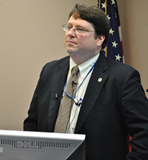DOT Safety Council Transforms Departmental Culture
The Department of Transportation (DOT) Safety Council is leading a transformative shift in DOT's safety culture by breaking down organizational silos and leveraging best safety practices throughout the department, according to Volpe's Dr. Stephen Popkin, an expert in the field of transportation human factors and an executive agent to the council. The council moves DOT's commitment to safety to a higher level by instituting cross-modal safety discussion and action. Chaired by the Transportation Deputy Secretary, this council, composed of the heads of each DOT modal administration, their senior safety officers, and senior officials from the Office of the Secretary (OST), strives to be widely recognized as the world's leader for safety in transportation.
 Dr. Popkin, speaking about the critical role of the DOT Safety Council during Volpe's Transportation Trajectories series, has a unique perspective on the council from his role as executive agent. In his talk, which was presented in-person and via webinar, Popkin noted that many important safety initiatives have been carried out for years within DOT's various operating administrations without a formal way of sharing information. The Safety Council seeks to change that practice. "Important goals of the council are to provide a forum for anticipating and addressing top emerging safety issues, and then sharing information and best practices throughout the department," said Popkin.
Dr. Popkin, speaking about the critical role of the DOT Safety Council during Volpe's Transportation Trajectories series, has a unique perspective on the council from his role as executive agent. In his talk, which was presented in-person and via webinar, Popkin noted that many important safety initiatives have been carried out for years within DOT's various operating administrations without a formal way of sharing information. The Safety Council seeks to change that practice. "Important goals of the council are to provide a forum for anticipating and addressing top emerging safety issues, and then sharing information and best practices throughout the department," said Popkin.
Popkin illustrated the critical role of the council and how it ultimately enhances the safety culture throughout the department. An operating administration can bring a best safety practice or an idea to the council, and after a vetting process, an important safety initiative can be implemented swiftly on a department-wide scale, significantly improving safety.
One of the council's key accomplishments to date has been the creation of the DOT Safety Policy, an internal policy for DOT employees to ensure a safe working environment. The launch of this internal policy, the first in the 42-year history of the department, aims to make DOT a leader in safe workplace practices.
Moving forward, the council plans to tackle additional safety issues. Dr. Popkin challenged listeners to think about safety in terms of emerging concerns and concepts that work in other operating administrations that may be applied across the entire department. He engaged the audience by asking for assistance in identifying potential new, significant cross-modal safety topics for consideration by the department's senior safety leaders.
The Transportation Trajectories series features Volpe experts engaging in dialogue on critical transportation issues. Dr. Popkin specifically encouraged people to become involved in the Safety Council's implementation team, which is led by Volpe. Getting involved with this highly visible council, which works alongside representatives from the White House and influences Congressional actions such as the surface reauthorization bill, offers a valuable opportunity to provide important feedback to this group and to help shape safety policy in the years to come.
Above: Volpe's Dr. Stephen Popkin speaks about the critical role of DOT's Safety Council. (Volpe photo)

